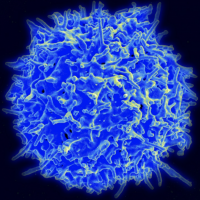The Cancer Survivors Network (CSN) is a peer support community for cancer patients, survivors, caregivers, families, and friends! CSN is a safe place to connect with others who share your interests and experiences.
NHL types and sub-types

Comments
-
-
Still Here !!!Rocquie said:Hi John
Haven't seen you around in a while. I recently heard (but don't remember where) that there are over 30 subtypes of NHL. I've only known about lymphoma for 9 months, but like you, I keep hearing of more and more differents ones.
I hope you are well. . .
Rocquie
Rocquie,
I am still here everyday and reading the post. I got interested in the types and sub-types awhile ago. I see every once in a while where someone has died of NHL. Usually in the newspaper, but it never says any more than that. Kind of leaves Ya' with your thumb up your butt wondering about what type. I am refering to a Dr. that lived in Md that died recently of NHL where I used to live. He was 89 yrs. old, but still no details. I am sure this happens to others here as well when they see articles like this, but no details.
When I first started posting 3 years ago I only knew of a few types. Now I see diagnosis that I have never heard of and do not know how to answer members. I really thought there were even more than 30 varieties, but not really sure. John
-
61-73 types and counting
I have seen numbers ranging from 61-73 types and sub-types of non-Hodgkin's lymphoma. Dr Stephen Shuster, one of the top lymphoma doctors in the nation at the University of Pennsylvania, says that nothing is certain in life except death, taxes and new sub-types of lymphoma. Each and every PTCL-NOS patient has an unknown sub-type of T-Cell Lymphoma that is waiting to be categorized. There may be hundreds or even thoudands of sub-types, so complex is the human organism. My variety appeared to be AngioImmunoblastic T-Cell Lymphoma, yet there was some debate over classifying it even at Fred Hutchinson. It was finally tossed into the "NOS" (Not Otherwise Specified) category - an unknown sub-type.
-
Whew !!!!po18guy said:61-73 types and counting
I have seen numbers ranging from 61-73 types and sub-types of non-Hodgkin's lymphoma. Dr Stephen Shuster, one of the top lymphoma doctors in the nation at the University of Pennsylvania, says that nothing is certain in life except death, taxes and new sub-types of lymphoma. Each and every PTCL-NOS patient has an unknown sub-type of T-Cell Lymphoma that is waiting to be categorized. There may be hundreds or even thoudands of sub-types, so complex is the human organism. My variety appeared to be AngioImmunoblastic T-Cell Lymphoma, yet there was some debate over classifying it even at Fred Hutchinson. It was finally tossed into the "NOS" (Not Otherwise Specified) category - an unknown sub-type.
I knew there were a lot of types, but never imagined there were that many out there. Like I was saying before when I first started to post I remember seeing where there were many sub types, but can not remember how many. I guess in a way it shows with the discovery there being so many out there they have maybe zeroed in more. That may be a good thing. Possibly isolating it for better treatment. I hope it's not wishful thinking. I do feel they have come pretty far in the past few years. It's just when I see someone has not beat this crap and the NHL has won the battle it get my mind working. I wish they would go into more detail for the sake of others going thru this. John
-
LymphomaInfo.net
Hi John,
I did a little research and came across this information at LymphomaInfo.net...it's current information...dated May 2013. Hope this helps a little. Sue (FNHL-stg3-grd2-typA-Dx 6/10-age 62)
Lymphoma subtypes
Lymphomas are cancers that develop in lymph cells found in the lymphatic system, either in tissue, nodes, or lymphatic organs. Lymphomas that develop from B-cells are therefore of B-cell origin and are B-cell lymphomas. Those that develop from T-cells are of T-cell origin and are T-cell lymphomas.
From there, the number of subtypes of B-cell and T-cell lymphomas has grown from ten to 30 to 60 and will very likely be in the high triple digits soon. As lymphomas become more and more classified at the molecular level, the list of subtypes expands exponentially.
While some of these new subtypes have names—follicular lymphoma, diffuse large B-cell lymphoma, anaplastic large cell lymphoma, angioimmunoblastic T-cell lymphoma—many do not; they are simply referred to by the chromosomal translocation that is distinctive to that tumor. You can get an idea of what I mean by visiting the classification of B-cell lymphomas at the Atlas of Genetics and Cytogenetics in Oncology and Haematology.
-
Key is that most have theallmost60 said:LymphomaInfo.net
Hi John,
I did a little research and came across this information at LymphomaInfo.net...it's current information...dated May 2013. Hope this helps a little. Sue (FNHL-stg3-grd2-typA-Dx 6/10-age 62)
Lymphoma subtypes
Lymphomas are cancers that develop in lymph cells found in the lymphatic system, either in tissue, nodes, or lymphatic organs. Lymphomas that develop from B-cells are therefore of B-cell origin and are B-cell lymphomas. Those that develop from T-cells are of T-cell origin and are T-cell lymphomas.
From there, the number of subtypes of B-cell and T-cell lymphomas has grown from ten to 30 to 60 and will very likely be in the high triple digits soon. As lymphomas become more and more classified at the molecular level, the list of subtypes expands exponentially.
While some of these new subtypes have names—follicular lymphoma, diffuse large B-cell lymphoma, anaplastic large cell lymphoma, angioimmunoblastic T-cell lymphoma—many do not; they are simply referred to by the chromosomal translocation that is distinctive to that tumor. You can get an idea of what I mean by visiting the classification of B-cell lymphomas at the Atlas of Genetics and Cytogenetics in Oncology and Haematology.
Key is that most have the same or similar treatment regimen. For example follicular has a a bunch of subtypes but treatment is similar or even identical for most of them.
-
Typesunknown said:Key is that most have the
Key is that most have the same or similar treatment regimen. For example follicular has a a bunch of subtypes but treatment is similar or even identical for most of them.
I guess what is clear is that there are a lot of varieties of lymphoma. When I first began reading about the disease about five years ago, most of the the summarys said something like "around 30 commonly recognized subvariants [of NHL], and numerous other uncommon ones." No one submitted a guess as to what "numerous" meant.
HL is a little less broad, and has five classic or "commonly recognized" variants. My own strain is the rarest of those five, and doctors have debated whether it is best classed as a form of HL or NHL, but the consensus at present is to continue to regard it as HL. But, that does confuse treatment. It is treated with abvd, which is the standard HL treatment for all five, unless some odd factors suggest something else. As GKH noted, most NHLs start with r-chop, or one of the other standards, unless it is a strain that history shows does not respond to chop, or responds much better to something else.
I doubt that there are any more strains of lymphoma now than there were decades ago (it is not contagious, and a new variant therefore would either be put in remission in that patient or die with that patient). What most likely has changed is better pathology techniques, and better reporting, due to the internet and such.
max
-
Treatment is all in the proteinsTypes
I guess what is clear is that there are a lot of varieties of lymphoma. When I first began reading about the disease about five years ago, most of the the summarys said something like "around 30 commonly recognized subvariants [of NHL], and numerous other uncommon ones." No one submitted a guess as to what "numerous" meant.
HL is a little less broad, and has five classic or "commonly recognized" variants. My own strain is the rarest of those five, and doctors have debated whether it is best classed as a form of HL or NHL, but the consensus at present is to continue to regard it as HL. But, that does confuse treatment. It is treated with abvd, which is the standard HL treatment for all five, unless some odd factors suggest something else. As GKH noted, most NHLs start with r-chop, or one of the other standards, unless it is a strain that history shows does not respond to chop, or responds much better to something else.
I doubt that there are any more strains of lymphoma now than there were decades ago (it is not contagious, and a new variant therefore would either be put in remission in that patient or die with that patient). What most likely has changed is better pathology techniques, and better reporting, due to the internet and such.
max
The NHLs that are CD20 or CD30 positive have a known set of treatments. Still, not all lymphomas respond to those. Those which do not express this protein on the cell surface are in a separate treatment category, and targeted therapies (if any are available) seem to be the way to go with them. T-cell lymphomas will sometimes respond to the standard CHOP therapy but often will simply laugh at it. Some of them seem to ignore all treatments. Add to this that lymphomas are some of the most difficult to diagnose of the common cancers due to the wide variety in cell appearance and misdiagnoses are still all too common. In my case, the local patholology lab did not see any cancer. Second opinions!
-
Thanks everyonepo18guy said:Treatment is all in the proteins
The NHLs that are CD20 or CD30 positive have a known set of treatments. Still, not all lymphomas respond to those. Those which do not express this protein on the cell surface are in a separate treatment category, and targeted therapies (if any are available) seem to be the way to go with them. T-cell lymphomas will sometimes respond to the standard CHOP therapy but often will simply laugh at it. Some of them seem to ignore all treatments. Add to this that lymphomas are some of the most difficult to diagnose of the common cancers due to the wide variety in cell appearance and misdiagnoses are still all too common. In my case, the local patholology lab did not see any cancer. Second opinions!
Thanks everyone for responding to my post. It all really helps a lot. John
Discussion Boards
- All Discussion Boards
- 6 Cancer Survivors Network Information
- 6 Welcome to CSN
- 122.6K Cancer specific
- 2.8K Anal Cancer
- 456 Bladder Cancer
- 312 Bone Cancers
- 1.7K Brain Cancer
- 28.6K Breast Cancer
- 407 Childhood Cancers
- 28K Colorectal Cancer
- 4.6K Esophageal Cancer
- 1.2K Gynecological Cancers (other than ovarian and uterine)
- 13.1K Head and Neck Cancer
- 6.4K Kidney Cancer
- 683 Leukemia
- 804 Liver Cancer
- 4.2K Lung Cancer
- 5.1K Lymphoma (Hodgkin and Non-Hodgkin)
- 242 Multiple Myeloma
- 7.2K Ovarian Cancer
- 70 Pancreatic Cancer
- 493 Peritoneal Cancer
- 5.6K Prostate Cancer
- 1.2K Rare and Other Cancers
- 544 Sarcoma
- 744 Skin Cancer
- 661 Stomach Cancer
- 192 Testicular Cancer
- 1.5K Thyroid Cancer
- 5.9K Uterine/Endometrial Cancer
- 6.4K Lifestyle Discussion Boards



